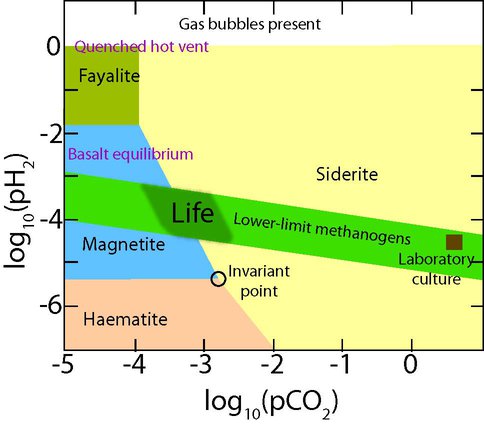2010 Annual Science Report
 VPL at University of Washington
Reporting | SEP 2009 – AUG 2010
VPL at University of Washington
Reporting | SEP 2009 – AUG 2010
Planetary Surface and Interior Models and SuperEarths
Project Summary
We use computer models to simulate the evolution of the interior and the surface of real and hypothetical planets around other stars. Our goal is to work out what sorts of initial characteristics are most likely to contribute to making a planet habitable in the long run. Observations in our own Solar System show us that water and other essential materials are continuously consumed via weathering (and other processes) and must be replenished from the planet’s interior via volcanic activity to maintain a biosphere. The surface models we are developing will be used to predict how gases and other materials will be trapped through weathering over time. Our interior models are designed to predict how much and what sort of materials will come to a planet’s surface through volcanic activity throughout its history.
Project Progress
Weathering Models
We continued to develop and use a reactive transport model to simulate weathering at planetary surfaces. The minerals and solute species associated with reactions with CO2 were expanded. Volatile exchange between soil and atmosphere for 8 gases is being tested. Recently implemented iron redox kinetics and speciation is also in testing. We formulated a new implicit method to decrease computational time, as testing revealed that the previous method was not helpful. Coding is in progress, and testing is planned for the immediate future.
Tidal Heating and Thermal Evolution
We have made considerable progress toward development of an integrated model to simulate the thermal evolution of planets subjected to tidal heating. The present model calculates non-tidal heat and material fluxes (those arising from mantle convection, conduction, volcanic activity, radioactive decay, etc.) using a simple 1-D numerical model. At the end of each timestep, tidal dissipation is calculated using a 3-D model, tidal dissipation heat fluxes are fed back into the 1-D thermal evolution portion of the code, and the whole suite of models advances to the next timestep.
The present model suite is designed to simulate the evolution bodies as small as Jovian moons and as large as so-called Super-Earths (~10 Earth masses). We have begun to explore algorithms for co-varying physical parameters over such a large mass range to ensure self-consistency in each run.
Tectonic style plays a major role in thermal evolution. Broadly speaking, Earth undergoes plate tectonics. Venus experiences stagnant lid tectonics. Within the broader framework of plate tectonics, areas such as cratons on Earth function as local lids. There are two basic styles of lid: chemical and stagnant. Convection under a chemical lid extends up to the layer where the density and viscosity contrast between the chemically distinct mantle and crust terminates it. Convection under a stagnant lid extends upward to the level at which the temperature is too low (and the viscosity is therefore too high) to sustain convection in the mantle material. We have found that Earth’s cratons are near the transition from chemical lid to stagnant lid. This suggests that chemical lids may easily develop on super-earths.
Earth as a Test Case
Our studies of the gross geochemical signatures related to life continue apace. In particular, we have explored the nature of biological signatures in hard crustal rocks and in the mantle. We have found that life greatly increases sulfur in arc volcanics. Our most recent work has focused on determining what geological environments require life with photosynthesis and thus cannot be pre-biotic candidates.
Figure 2: Mineral stability diagram for fayalite Fe2SiO4, magnetite Fe3O4, haematite Fe2O3, and siderite FeCO3 in pCO2 and pH2 space at 25°C. The activity of quartz SiO2 is 1 (saturation). Methanogens can gain useful energy from CO2 and H2 above the green line calibrated with the laboratory culture of Kral et al. (1998). The approximate pH2 for black smoker vent fluid from basalt with ~1 mMol H2 is obtained from the field data, laboratory results, thermodynamic calculations. Fluid equilibrated with basalt at 25°C has pH2 ~2.5 orders of magnitude lower (Sleep et al., 2001); for reference by stoichiometry, pH2 in equilibrium with (Fe0.17Mg0.83)2SiO4 (representing basalt) is 1 order of magnitude below that of pure fayalite. Life at the time of banded iron formation tended to dynamically buffer the water near the intersection of the methanogen line and the magnetite-siderite stability line. Magnetite is consumed at the invariant point without redox reaction. The pH2 in the ocean and atmosphere could not have been far above that level. Modified after Rosing et al. (2010).
Publications
-
Rosing, M. T., Bird, D. K., Sleep, N. H., & Bjerrum, C. J. (2010). No climate paradox under the faint early Sun. Nature, 464(7289), 744–747. doi:10.1038/nature08955
-
Sleep, N. H. (2009). Stagnant lid convection and carbonate metasomatism of the deep continental lithosphere. Geochem. Geophys. Geosyst., 10(11), n/a–n/a. doi:10.1029/2009gc002702
-
Sleep, N. H. (2010). The Hadean-Archaean Environment. Cold Spring Harbor Perspectives in Biology, 2(6), a002527–a002527. doi:10.1101/cshperspect.a002527
-
PROJECT INVESTIGATORS:
-
PROJECT MEMBERS:
Rory Barnes
Co-Investigator
Shawn Domagal-Goldman
Co-Investigator
Victoria Meadows
Co-Investigator
-
RELATED OBJECTIVES:
Objective 1.1
Formation and evolution of habitable planets.
Objective 1.2
Indirect and direct astronomical observations of extrasolar habitable planets.
Objective 4.1
Earth's early biosphere.
Objective 5.2
Co-evolution of microbial communities
Objective 6.1
Effects of environmental changes on microbial ecosystems



